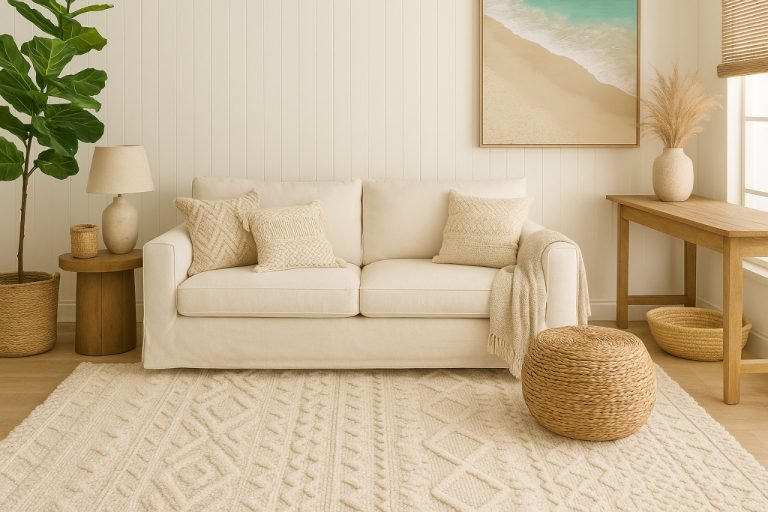Plush wool coastal boho rugs combine the tactile luxury of thick wool pile with artistic bohemian influences and a calming coastal palette. These rugs serve both functional and decorative roles, offering comfort underfoot, insulating floors, and grounding living spaces with texture and color. The overlap of these design elements makes these rugs ideal for those seeking warmth, casual elegance, and a connection to both nature and artisan craftwork in their interiors.
What Defines a Plush Wool Coastal Boho Rug?
A plush wool coastal boho rug integrates the softness of thick wool with design features that evoke a relaxed, beach-inspired lifestyle and artisanal, global aesthetics. The plush component comes from the wool’s dense, high-pile weave, creating tactile comfort and visual depth. The coastal influence is represented in calming color palettes such as creams, sands, blues, and aquas. The boho dimension adds artistic patterns inspired by tribal, vintage, and abstract design traditions. This fusion makes these rugs highly versatile for casual and curated interiors, particularly those that celebrate texture, natural materials, and a free-spirited vibe.
How Coastal Style + Boho Style Overlap
Coastal and boho styles intersect in their emphasis on comfort, natural elements, and relaxed aesthetics. Coastal design draws inspiration from oceanic environments, using light, breezy colors and organic textures like driftwood, linen, and sea glass. Boho style emphasizes eclecticism, incorporating global patterns, layered textiles, and vintage or handmade elements. When combined, they create a space that feels both curated and casual, grounding vibrant patterns in soothing tones for a look that is simultaneously fresh and soulful.
Plush vs Flatweave vs Shag
Plush rugs feature densely packed, high-pile wool that delivers cushion and comfort. In contrast, flatweave rugs are woven without a pile, offering a sleek, low-profile option ideal for layering or high-traffic areas. Shag rugs exaggerate texture with long, loose fibers that can feel luxurious but are more difficult to clean. Plush wool rugs strike a balance, offering both softness and structure, making them preferable for living areas and bedrooms where comfort and warmth are key.
Texture & Weave Types (Hand-tufted, Hand-knotted, Flat Weave)
The method of construction significantly affects the texture and durability of the rug. Hand-tufted rugs are crafted by punching yarn into a backing and then applying latex to hold the shape, making them more affordable but less durable. Hand-knotted rugs involve meticulous tying of knots and are known for their longevity and intricate detail. Flatweave rugs use interlaced warp and weft threads, creating lightweight, reversible textiles. Combining high-pile wool sections with flatweave borders or shag inserts can produce a visually rich, multidimensional rug.
How Can You Tell if a Rug is True 100% Wool, and Why Does It Matter?
Identifying a genuine 100% wool rug ensures durability, comfort, and environmental sustainability. Wool’s natural resilience makes it superior to synthetic alternatives in terms of longevity, flame resistance, and breathability. For buyers investing in a plush wool coastal boho rug, verifying authenticity also guarantees ethical sourcing and healthier indoor air quality by avoiding petrochemical fibers.
Smell and Burn Test

One way to verify wool authenticity is through the smell and burn test. When burned, real wool smells like burnt hair and leaves a soft ash residue. In contrast, synthetics emit a chemical odor and melt into hard beads. While not suitable in all buying contexts, this test can help in-person buyers avoid mislabeling.
Fiber Crimp and Texture

Natural wool fibers have a distinct crimp that provides elasticity and bounce. This crimp allows the rug to retain shape and resist matting, which synthetic fibers typically lack. Running fingers through wool reveals a springy, soft texture, while synthetics often feel stiffer or overly smooth.
Cost and Value Differences
Though wool rugs are more expensive upfront, their longevity justifies the investment. Hand-knotted wool rugs can last for decades, while synthetic rugs may flatten or deteriorate within a few years. Wool’s natural oils also help it resist soiling, which lowers long-term maintenance costs and improves its overall value.
What Pile Heights Make a Rug Truly “Plush,” and What Are Trade-offs?
A rug is considered truly “plush” when its pile height ranges between 0.75 inches and 1.5 inches, offering a luxuriously soft and cushioned feel underfoot. This high pile traps more air, enhancing insulation and comfort, but also increases maintenance requirements due to deeper dirt retention and difficulty in vacuuming. Plush rugs may flatten over time in high-traffic areas and are not ideal for households with pets, as fibers can trap fur and claws can snag easily. While they add elegance and tactile comfort to spaces like bedrooms or lounges, trade-offs include higher upkeep, reduced durability in busy zones, and furniture imprinting.
Low-pile vs Mid-pile vs High-pile
Low-pile rugs (0.25–0.5″) are easier to vacuum and suitable for dining areas or hallways. Mid-pile rugs (0.5–0.75″) strike a balance between comfort and practicality, making them ideal for multifunctional spaces like living rooms. High-pile rugs (0.75–1.5″) feel softest underfoot and are best used in low-traffic or cozy spaces like bedrooms.
What’s Comfortable Underfoot?
Comfort is maximized when pile height exceeds 0.75 inches and wool density is high. Dense fibers absorb shock and provide insulation, especially when paired with a felted rug pad. High pile is recommended for spaces where people sit or walk barefoot frequently.
What’s Practical for High-traffic Areas?
Mid-pile or tightly woven low-pile rugs offer better resilience in busy zones. High-pile rugs may trap debris and wear unevenly in such areas. Choosing a rug with a looped or tight cut-pile can provide plushness without sacrificing durability.
What Color Palettes & Motifs Suit Coastal + Boho Interiors?
Coastal + Boho interiors thrive on relaxed, nature-inspired color palettes and free-spirited motifs that evoke seaside tranquility and artistic individuality. Soft neutral tones like sand, ivory, driftwood beige, and warm whites form the base, complemented by oceanic blues, seafoam green, and sun-faded terracotta. Muted pastels such as blush, sage, and pale turquoise also work harmoniously within this aesthetic. Key motifs include organic patterns like waves, shells, palms, and tribal or ethnic prints such as mud cloth, Moroccan tiles, and Aztec geometrics. Layering textures macramé, rattan, linen, and weathered wood enhances the tactile and visual richness of the space.
Neutrals & Sun-faded Tones
Neutrals like beige, ivory, and off-white act as grounding elements in boho-coastal schemes. Sun-faded tones such as soft pink, terracotta, and misty green evoke weathered seaside structures and bring in subtle warmth without overpowering the decor.
Blue and Aqua Hues
Blues and aquas are signature coastal tones. Soft powder blue, deep navy, and turquoise mimic the ocean and sky. Incorporating these colors in borders, medallions, or wave-like patterns reinforces the rug’s coastal identity.
Tribal, Geometric, and Distressed Patterns
Bohemian motifs draw from Moroccan, Turkish, and Southwestern designs. These include diamond shapes, medallions, or repetitive lines. Distressing adds a vintage or handmade feel, often achieved through abrash dyeing techniques that create uneven, aged coloring.
How Much Pattern is “too Busy”?
Pattern density should reflect the room’s visual weight. In minimalist spaces, choose low-contrast designs. For eclectic rooms, larger-scale or bolder patterns work well. Scale, not just color, influences whether a rug feels overwhelming or balanced.
What Rug Sizes & Shapes Work Best in Different Rooms?
Rug sizes and shapes should align with the room’s dimensions, furniture layout, and functional zones. In living rooms, a large rectangular rug (8×10 or 9×12) anchors the seating area with all furniture legs on or off. Bedrooms benefit from 5×8 or 6×9 rugs placed under the bed, extending beyond for comfort. Dining rooms require rugs at least 24 inches larger than the table on all sides, typically 8×10 or larger. Round rugs suit entryways or under circular tables, while runners fit well in hallways or narrow kitchens. Proper sizing enhances spatial flow and aesthetic balance across room types.
Living Room Size Guidelines
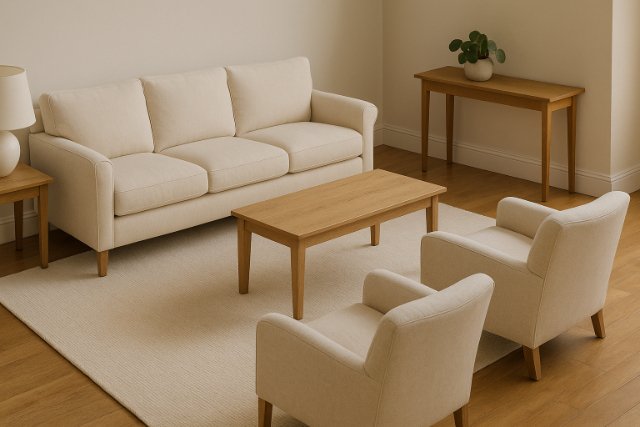
A rug in the living room should anchor the seating area. Ideally, all sofa and chair legs should rest either fully or partially on the rug. Common sizes are 8×10 for small rooms and 9×12 for larger arrangements. This helps unify furniture and define the space.
Dining Room Under-table Guidelines
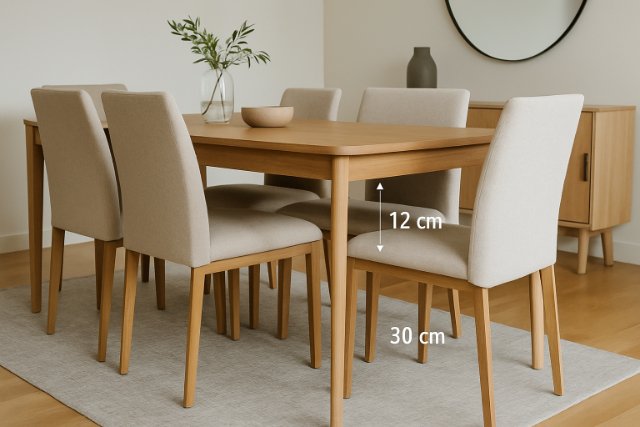
Dining room rugs must accommodate pulled-out chairs. The rug should extend at least 24 inches beyond the table edges on all sides. Low-pile options make sliding chairs easier and prevent crumbs from settling deep into fibers.
Layering Rugs
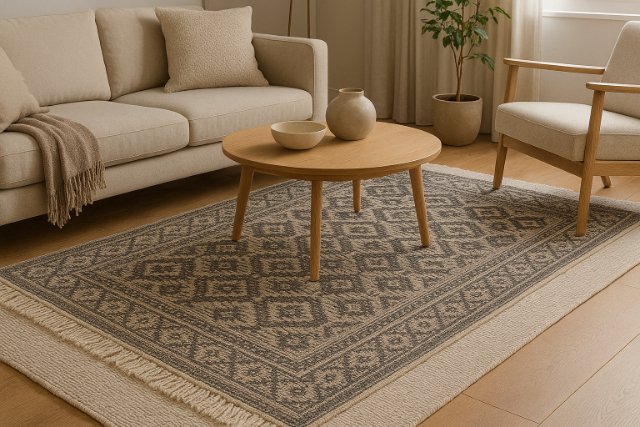
Layering adds visual richness. A large flatweave or jute base can be topped with a smaller plush wool rug to highlight a central seating zone. This also introduces contrasting textures and can define different functional zones within open floor plans.
Runner & Accent Rugs
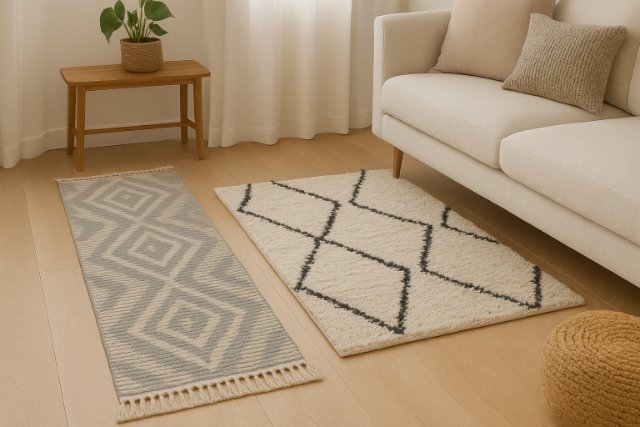
Runners suit hallways, kitchens, and narrow entryways, offering comfort and color without crowding the space. Accent rugs work in reading nooks, at the foot of a bed, or near sinks, often using bold patterns to energize these smaller areas.
Shape Considerations
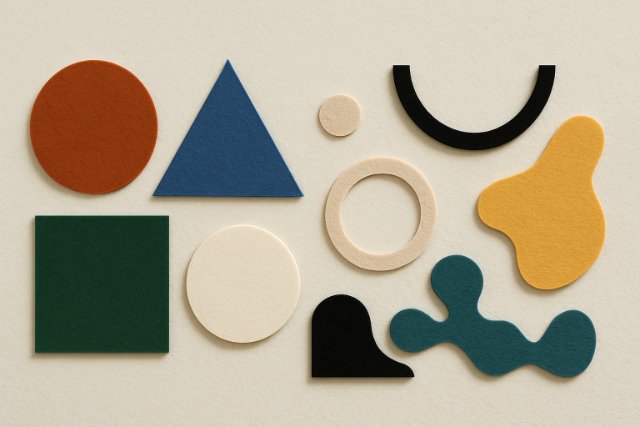
Shape should reflect the function and flow of the room. Round rugs soften harsh lines and draw attention to focal points like coffee tables. Oval rugs elongate small rooms. Rectangular rugs remain the most versatile, offering clear boundaries and coverage.
How Should You Care for and Clean a Wool Boho Coastal Rug?
To care for and clean a wool Boho Coastal rug, vacuum regularly using a suction-only attachment to avoid damaging the natural fibers. Blot spills immediately with a clean, dry cloth never rub. For deep cleaning, use a wool-safe carpet shampoo or consult a professional rug cleaner experienced with wool textiles. Rotate the rug every few months to ensure even wear and avoid prolonged exposure to direct sunlight to prevent fading. Avoid moisture-heavy environments, and always allow the rug to dry completely after spot cleaning to prevent mildew or fiber distortion.
Dealing With Shedding
Wool rugs naturally shed, especially when new. Shedding decreases over time with regular vacuuming using a suction-only head. Avoid high-pile brushes, which can pull fibers. Hand-knotted rugs typically shed less than tufted ones.
Protecting in Humid/coastal Climates
Humidity can attract mold or cause fibers to swell. Use breathable rug pads, dehumidifiers, and rotate rugs to allow even wear and ventilation. Avoid placing rugs directly under windows where salt air or rain exposure is higher.
Drying, Cleaning, Vacuuming Without Damaging Wool
Blot spills immediately with a dry cloth. Use cold water and wool-safe cleaners for spot cleaning. For deeper cleans, avoid soaking. Vacuum with gentle suction once a week and never use bleach or alkaline detergents.
When to Call a Professional
Call a rug professional for deep stains, odors, or annual maintenance. Professionals use wool-safe shampoos and drying techniques to preserve texture and color. Avoid dry-cleaners not familiar with wool care.
Where Should You Buy What Brands or Artisans Offer Good Value?
The best place to buy depends on aligning value with authenticity, durability, and cost efficiency. Established brands often provide reliability, warranties, and consistent quality, while artisans deliver unique craftsmanship, ethical sourcing, and cultural authenticity. Consumers seeking long-term value should compare material quality, transparency, and after-sales support before choosing.
Online Retailers
Online platforms provide extensive filters for size, style, and price. Revival Rugs offers artisan and vintage-inspired designs. The Citizenry focuses on ethically sourced wool rugs. Ruggable offers washable wool-blend options ideal for households with pets.
Artisan Makers
Global artisan collectives produce unique, hand-crafted rugs. Brands like Beni Rugs or Soukie Modern partner with weavers in Morocco and Turkey. Purchasing directly supports fair labor and traditional techniques.
Custom Rugs
Customizable platforms like Loomy or Armadillo allow personalization of dimensions, colors, and patterns. These suit unique spaces or design-driven projects. Expect longer delivery times and higher prices.
How to Evaluate Value
Examine knot density (for hand-knotted rugs), wool source, certification (e.g., GoodWeave), return policy, and origin. Consider long-term use and maintenance rather than just upfront cost. Warranty support also adds value.
What Are the Sustainability & Ethical Considerations?
Sustainability and ethical considerations involve evaluating the long-term environmental, social, and governance impacts of decisions, ensuring resources are used responsibly while respecting human rights, labor practices, and biodiversity. Organizations must minimize ecological footprints, support fair trade, promote transparency, and align operations with global sustainability goals to achieve ethical growth.
Natural Dyes
Natural dyes derived from plants, minerals, and insects create complex, lasting colors and reduce environmental toxicity. These dyes are biodegradable, safer for indoor air, and enhance the artisanal quality of the rug.
Fair Trade & Artisan Made
Fair Trade certifications guarantee that workers receive living wages and safe working conditions. Artisan-made rugs also preserve cultural heritage and techniques that mass-produced alternatives often erase.
Environmental Footprint of Wool vs Synthetics
Wool is biodegradable, renewable, and naturally insulating. Synthetic rugs, made from petroleum-based fibers, consume more energy and often release VOCs. Wool’s durability and renewability make it the greener choice.
Durability as sustainability
Longevity is key to sustainability. A well-cared-for wool rug can last generations, reducing the need for replacements and lowering overall resource consumption. Durability also protects your investment in design and comfort.
Conclusion
Plush wool coastal boho rugs combine tactile luxury, artisan beauty, and sustainable materials. Their role in softening interiors, grounding rooms, and expressing personal style makes them essential for curated living. Choosing the right rug involves understanding material quality, pattern harmony, appropriate sizing, and responsible sourcing. In coastal environments, smart care ensures longevity. With the right guidance, every home can enjoy the calming, textural, and expressive beauty these rugs provide.
FAQ’s
Pile heights above 0.75 inches are considered plush. Measurement is taken from the base of the rug to the tip of the fibre. Wool’s density adds to the perception of softness.
Wool naturally sheds, especially when new. Use a vacuum without a beater bar and avoid foot traffic initially. High-quality wool with tight weave sheds less over time.
Yes, if properly ventilated and used with a breathable rug pad. Regular rotation, sun protection, and spot drying help prevent mildew. Wool’s moisture-wicking helps too.
Wool is hypoallergenic, flame-resistant, and free from toxic chemicals. It’s safe for families, though shedding may be an issue for pets that like to scratch or dig.
Blot stains, avoid soaking, use mild wool-safe detergent, and vacuum with care. Professional cleaning is advised yearly. Never use bleach or harsh chemicals.
Soft neutrals, sandy beiges, pale blues, aquas, and muted pastels blend both aesthetics. Patterns in tribal or distressed styles bring a boho edge without clashing.
Prices range from $200 (small hand-tufted) to $3000+ (large hand-knotted). Cost depends on wool quality, pile height, knot density, country of origin, and whether handmade.
Look for brands like The Citizenry, Armadillo, and Made Trade. Ensure certifications like Fair Trade, GoodWeave, or OEKO-TEX for environmental and ethical assurance.


